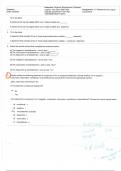Student:., ; i Legault, Juan Silva, Math Dept Assignment: 3.1 Statements and Logical
Date: 03/25/24 Course: 2242-MATH-1301-502- Connectives
CONTEMPORARY MATH
Fill in the blank.
A sentence that can be judged either true or false is called a(n)
A sentence that can be judged either true or false is called a(n) statement.
2. Fillin the blank.
A statement that consists of two or more simple statements is called a statement.
A statement that consists of two or more simple statements is called a compound statement.
3. Select the correct choices that complete the sentences below.
a) The negation is symbolized by ~ and is read " .
b) The conjunction is symbolized by A and is read "
c¢) The disjunction is symbolized by Vv and is read " N
a) The negation is symbolized by ~ and is read "not."
b) The conjunction is symbolized by A and is read "and."
c) The disjunction is symbolized by v and is read “or."
@Decide whether the following statement is compound. If it is a compound statement, indicate whether it is a negation,
conjunction, disjunction, conditional, or biconditional by using both the word and its appropriate symbol.
Julie's sister likes swimming for fun.
Is the statement a compound statement?
¥ No
Yes
If the statement is compound, is it a negation, conjunction, disjunction, conditional, or biconditional? Choose the correct answer below.
* A. conditional, —
B. negation, ~
¥ C. The statement is simple.
: D. disjunction, Vv
E. conjunction, A
> F. biconditional, <
, 5. Indicate whether the statement is a simple or a compound statement. If it is a compound statement, indicate whether it is a negation,
conjunction, disjunction, conditional, or biconditional by using both the word and its appropriate symbol.
Statement: A triangle is isosceles if and only if it has two sides that are the same length.
Is the above statement simple or compound?
A. The statement is a simple statement because it has only one idea.
:¥B. The statement is a compound statement because it combines two or more simple statements.
C. The statement is a compound statement because it has only one idea.
7.+ D. The statement is a simple statement because it combines two or more simple statements.
If the statement is compound, is it a negation, conjunction, disjunction, conditional, or biconditional? Select the correct choice below and,
if necessary, fill in the answer box to complete your choice.
" A. The statement is a disjunction. It is represented by the symbol
- B. The statement is a conditional. It is represented by the symbol
»* €. The statement is a conjunction. It is represented by the symbol
© D. The statement is a negation. It is represented by the symbol
WE, The statement is a biconditional. It is represented by the symbol «
: F. The statement is simple.
6. Indicate whether the statement is a simple or a compound statement. If it is a compound statement, indicate whether it is a negation,
conjunction, disjunction, conditional, or biconditional by using both the word and its appropriate symbol.
Statement: Dave likes to play football and he likes to play soccer.
Is the above statement simple or compound?
* A, The statement is a simple statement because it combines two or more simple statements.
. B. The statement is a simple statement because it has only one idea.
.- C. The statement is a compound statement because it has only one idea.
¥D. The statement is a compound statement because it combines two or more simple statements.
If the statement is compound, is it a negation, conjunction, disjunction, conditional, or biconditional? Select the correct choice below and,
if necessary, fill in the answer box to complete your choice.
YA The statement is a conjunction. It is represented by the symbol A
B - The statement is a disjunction. It is represented by the symbol
©: C. The statement is a biconditional. It is represented by the symbol
* + D D. The statement is a conditional. It is represented by the
symbol W
~ E. The statement is a negation. It is represented by the symbol_ M\t«/ o
X
I+ F. The statement is simple. / bV
~
ve V \




